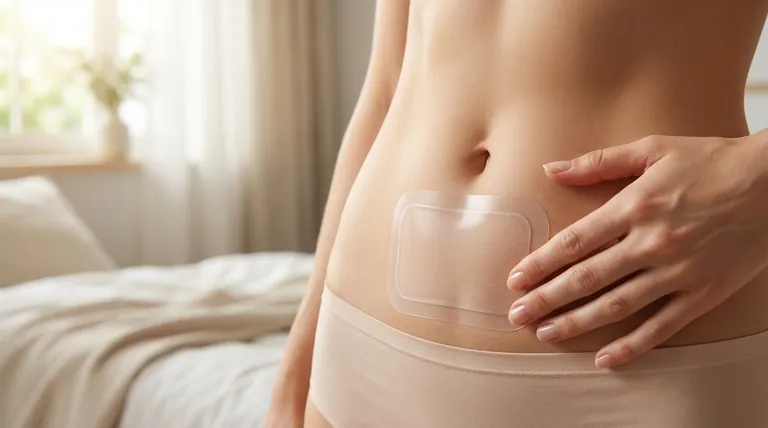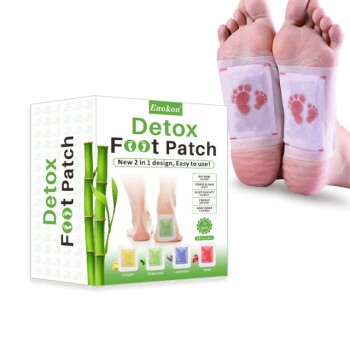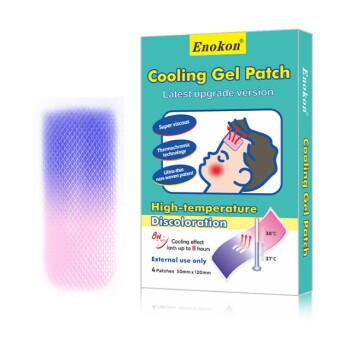At its core, an estrogen patch is a transdermal delivery system. This thin, adhesive patch is applied directly to the skin, where it releases a steady, controlled dose of estrogen hormone. The hormone is absorbed through the skin layers and enters the bloodstream directly, providing consistent levels throughout the body.
The fundamental advantage of the estrogen patch is its ability to deliver a continuous, low dose of hormones. This method bypasses the digestive system and liver, mimicking the body's natural hormone release more closely than oral medications.

The Mechanism of Transdermal Delivery
Transdermal therapy is a sophisticated method for introducing medication into the body. The patch is engineered to overcome the skin's natural barrier in a controlled manner.
From Patch to Bloodstream
An estrogen patch contains a reservoir of the hormone within its layers. Once applied, the concentration difference between the patch and the skin drives the estrogen molecules to migrate through the epidermis and dermis.
They are then absorbed by the dense network of tiny blood vessels (capillaries) in the deeper skin layers, entering the systemic circulation to be transported throughout the body.
The Importance of Consistent Levels
Unlike oral pills, which can cause hormone levels to spike after a dose and fall before the next one, a patch provides a steady state of estrogen.
This consistency can lead to more effective symptom management and potentially fewer side effects. It avoids the "first-pass metabolism," where drugs taken orally are partially broken down by the liver before ever reaching the rest of the body.
Key Applications for Estrogen Therapy
The ability to restore and stabilize estrogen levels makes patches a vital tool for several distinct medical goals.
Managing Menopausal Symptoms
For many individuals, the primary use is menopausal hormone therapy. A patch can effectively alleviate common symptoms like hot flashes, night sweats, and mood swings by replacing the estrogen the body no longer produces.
Treating Estrogen Deficiency (Hypoestrogenism)
Hypoestrogenism is a condition of clinically low estrogen that can result from various factors, including excessive exercise, restrictive diets, or certain medical procedures. Patches help restore estrogen to a healthy baseline.
Supporting Bone Health
Estrogen plays a crucial role in maintaining bone density. By providing a stable supply of the hormone, patches are used to help prevent osteoporosis in postmenopausal individuals.
Gender-Affirming Care
Estrogen patches are a common component of feminizing hormone therapy for transgender women. They provide the estrogen necessary to help induce physical changes that align with their gender identity.
Understanding the Trade-offs and Best Practices
While effective, the success of a patch depends entirely on proper use and understanding its limitations. Incorrect application can render the treatment ineffective.
Proper Application is Non-Negotiable
The patch must be applied to clean, dry skin, typically on the lower abdomen, hips, or buttocks. These areas have a good blood supply and are less prone to being rubbed by clothing.
Crucially, never apply a patch to the breasts.
Avoiding Interference
External factors can easily disrupt hormone absorption. Avoid applying lotions, oils, or powders to the area, as they can create a barrier.
Direct sun exposure and tight clothing that constantly rubs against the patch can also interfere with its adhesion and delivery mechanism.
The Need for Site Rotation
To prevent skin irritation, it is standard practice to rotate the application site. When you apply a new patch, choose a different spot from the previous one. This gives the skin time to recover.
Making the Right Choice for Your Goal
Deciding on a hormone delivery system is a clinical decision that depends on your specific health profile, goals, and lifestyle.
- If your primary focus is stable hormone levels: The patch is an excellent choice, as it provides consistent delivery and avoids the hormonal spikes of oral medication.
- If your primary focus is convenience: A patch that is changed only once or twice a week may be preferable to a daily pill or gel application.
- If you have sensitive skin or a very active lifestyle: You must consider the potential for skin irritation or issues with the patch staying on during heavy sweating or activity.
- If you have certain liver or digestive conditions: Your healthcare provider may specifically recommend a transdermal patch to bypass the gastrointestinal tract and initial liver metabolism.
Understanding how an estrogen patch functions is the first step in having a productive conversation with your provider about the right therapy for you.
Summary Table:
| Feature | Estrogen Patch | Oral Pills |
|---|---|---|
| Delivery Method | Through the skin (transdermal) | Swallowed (oral) |
| Hormone Levels | Steady, consistent | Peaks and troughs |
| Liver Processing | Bypasses first-pass metabolism | Processed by the liver first |
| Application Frequency | Once/twice weekly | Daily |
Partner with Enokon for Your Transdermal Patch Needs
As a bulk manufacturer of reliable transdermal patches and pain plasters, Enokon provides healthcare and pharmaceutical distributors and brands with high-quality, consistent hormone delivery systems. Benefit from our technical expertise for custom R&D and development to create the perfect patch for your product line.
Contact our experts today to discuss your project requirements.
Visual Guide

Related Products
- Prostate Pain Kidney Health Care Patch for Men
- Capsaicin Chili Medicated Pain Relief Patches
- Menthol Gel Pain Relief Patch
- Far Infrared Deep Heat Relief Patches Medicated Pain Relief Patches
- Icy Hot Menthol Medicine Pain Relief Patch
People Also Ask
- What should be done if a testosterone patch falls off? A Guide to Maintaining Hormone Stability
- What lifestyle factors should be considered when choosing between testosterone patches and injections? Find Your Best Fit
- What should be done if a testosterone patch is missed or falls off? Follow these simple timing rules for safety and consistency.
- What should be done in case of a testosterone patch overdose? A Step-by-Step Emergency Guide
- What should be done before undergoing an MRI while using testosterone patches? Remove it to prevent serious burns.















